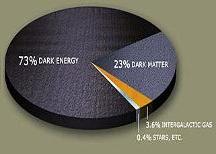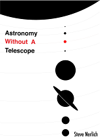Cheap cosmology
Cheap cosmology—the vital statistics
Disclaimer
PhD’s cost a lot of money and take a considerable amount of time and effort to complete. Here at Cheap Astronomy we have cobbled together the following narrative in the absence of any such authoritative basis.
Cosmo-what?
Cosmology is concerned with developing theoretical models about the formation, age and evolution of the universe and its contents, based on observational evidence collected through astronomy and other sciences—notably particle physics.
What is the universe made of?
In its early stages, the universe was pretty much pure energy and only later did any kind of matter begin to appear as a result of the universe cooling as it expanded. Some cosmologists loosely refer to matter as ‘frozen energy’. So, we need to describe what the universe is made of in terms of both matter and energy:
- 73% Dark energy—we don’t know what this is, but there is compelling evidence for its existence based on observations that the universe appears to be expanding at an accelerating rate. The spread-out ‘flatness’ of the universe suggests that there is an awful lot of this expansive energy to account for.
- 23% Dark matter—we don’t know what this is either, but it needs t
 o be there. There is not nearly enough visible/detectable matter to generate the gravity required to hold galaxies—and clusters of galaxies—together.
o be there. There is not nearly enough visible/detectable matter to generate the gravity required to hold galaxies—and clusters of galaxies—together. - 4% Baryonic matter—we know lots about this, are made of it and spend our lives walking around on it. Indeed any directly observable objects are baryonic matter (all the stars, planets etc). By exclusion this defines something about dark matter, it’s not baryonic.
How old is the universe and how did it start?
It’s about 13.7 billion years old. Needless to say, how it started is a long story and the details are still being figured out. For a brief precise, try Cheap Astronomy’s quick, easy and amateur introduction.![]()
How big is the universe?
The observable universe is about 93 billion light years in diameter. It is quite likely that the universe is much bigger, but any regions beyond 93 billion light years are not only undetectable, but ‘unknowable’ by current scientific theory.
How do we know all this?

Edwin Hubble used the state-of the-art telescopes of his day to firstly show lots of fuzzy patches were indisputably other galaxies and went on to show that the more distant a galaxy was, the more red-shifted it was. This is a clear indication that we live in expanding universe. The more distant a galaxy is, the more space there is between you and it—all of which is undergoing expansion. Thus the spectrum of light from a distant galaxy is much more stretched (i.e. red-shifted), than light from a close one.
 Albert Einstein, a little before Hubble, developed a mathematical model of the universe from his work on general relativity. One obvious problem was how to explain why the universe didn’t just collapse in on itself due to the gravitational attraction of the matter within it. He introduced the cosmological constant to account for this—essentially a mysterious expansive force to counteract gravity. Upon hearing of Hubble’s work, he had a Doh! moment, but history has looked well on him as the first person to suggest that there needed to be an expansive force in the universe—that stuff we now call dark energy (because we still don’t know what it is).
Albert Einstein, a little before Hubble, developed a mathematical model of the universe from his work on general relativity. One obvious problem was how to explain why the universe didn’t just collapse in on itself due to the gravitational attraction of the matter within it. He introduced the cosmological constant to account for this—essentially a mysterious expansive force to counteract gravity. Upon hearing of Hubble’s work, he had a Doh! moment, but history has looked well on him as the first person to suggest that there needed to be an expansive force in the universe—that stuff we now call dark energy (because we still don’t know what it is).
Any astronomical observation is a look into the earlier life of the universe. Looking around we find the universe looks pretty much the same in every direction, in terms of matter distribution and space-time. This isotropy gives some validity to the Big Bang model which poses that the universe and everything in it expanded from a single point in all directions in a fairly even fashion.
The Cosmic Microwave Background (CMB) is the earliest observation possible. Originally the first burst of tremendously hot, powerful radiation from the broiling plasma of the primeval universe, it is now so vastly red-shifted that it has a temperature of only 2.7 Kelvin and can only be observed by radio  astronomy. The CMB is also very isotropic, but at a fine level of detail it is anisotropic (i.e. there are lumps and bumps) which gives us much useful data about the early universe. The Wilkinson Microwave Anisotropy Probe (WMAP) has been the source of much of this data in recent years.
astronomy. The CMB is also very isotropic, but at a fine level of detail it is anisotropic (i.e. there are lumps and bumps) which gives us much useful data about the early universe. The Wilkinson Microwave Anisotropy Probe (WMAP) has been the source of much of this data in recent years.
The CMB is a baby photo of the universe when it was about 380,000 years old. Understanding what happened before that is an exercise in building mathematical models of the increasing temperature and energy densities required as the universe is packed into an increasingly smaller volume. This is where particle accelerators, like the Large Hadron Collider, come in, providing data about what happens to particles in the high energies and temperatures of the early universe. What we find is that familiar atomic particles break down into more fundamental particles like quarks and gluons as the strong, weak and electromagnetic forces are progressively overcome. This takes us from the first three minutes (the title of a good book) down to a fraction of the first second.
Determining what happened at the absolute beginning is still the stuff of complex theoretical modelling based on scanty data. Current thinking involves a quantum fluctuation, a de-unification of the four forces and a bit of symmetry breaking thrown in. Cheap Astronomy has had a go at cobbling a story together here, but no-one is saying that we have all the answers yet.




